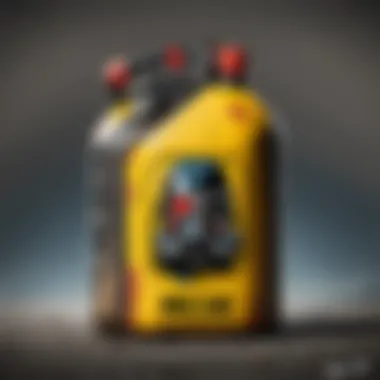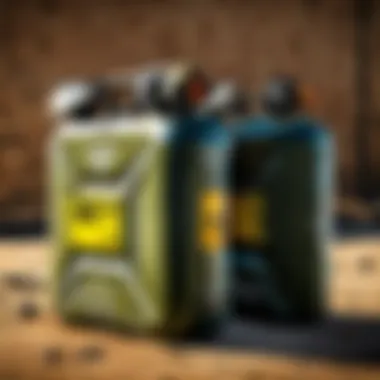The Versatile Uses of Portable Gas Canisters


Intro
Portable gas canisters are completely unheralded gems in the realm of outdoor enthusiasts and preparedness aficionados. Many might view them simply as a fire starter for camping or grilling, but their applications extend far beyond the confines of a campsite. They represent a blend of utility, safety, and convenience, catering to a diverse range of scenarios including emergency situations, recreational activities, and even regular household use.
It's easy to overlook how critical these items can be when the stakes are high, a fact that underscores their significance in our daily lives. From weekend camping trips under the stars to sudden power outages, the presence of a reliable gas source can mean the difference between a well-prepared response and an unfortunate dilemma. Thus, this exploration into the world of portable gas canisters seeks to elucidate not just their core functionalities but also the best practices and safety protocols that ensure their effective use.
Throughout this guide, we will embark on a detailed discussion, unpacking various aspects such as how these canisters are manufactured, the safety standards they must adhere to, and the wide-ranging benefits they offer in practical terms. So strap in, as we dive deep into the multifaceted applications that make portable gas canisters an essential tool in many of life’s scenarios.
Understanding Portable Gas Canisters
Portable gas canisters, often overlooked until a necessity arises, play a crucial role in various applications across multiple industries. By providing a reliable and convenient energy source, these canisters can transform situations that require quick, efficient fuel solutions. Whether you're heading out for a weekend camping trip or preparing for a possible emergency at home, understanding portable gas canisters becomes paramount for ensuring safety and usability.
They offer more than just functionality; they embody the essence of preparedness. Recognizing the diversity and capabilities of gas canisters allows users to choose the right type for their specific needs. This article endeavors to dissect the various aspects of portable gas canisters, focusing on what they are made of, the popular types available, and how they are utilized in different fields.
Ultimately, an informed approach to using portable gas canisters not only enhances convenience but also minimizes risks associated with their use. The practicality and relevance of integrating portable gas canisters into daily activities cannot be overstated. Let's delve into their composition and types to appreciate their versatile nature further.
Safety Considerations
Safety is the cornerstone when dealing with portable gas canisters. These devices hold the potential for great convenience but also pose significant risks if mishandled. Understanding how to work with gas canisters safely ensures not only your well-being but also enhances the efficiency of their use in various applications. No one wants a camping trip or emergency preparation to go south due to negligence surrounding safety issues.
Understanding Gas Properties and Hazards
Gas properties like flammability, pressure, and temperature sensitivity underpin the risks associated with portable gas canisters. A clear grasp of these properties can guide users in making informed decisions. For instance, both propane and butane have distinct characteristics. Propane remains gaseous at lower temperatures and is best suited for colder conditions, while butane performs better in warmer environments. Knowing this helps users select the right fuel for their specific needs while minimizing hazards.
Moreover, the nature of gases means that no one should ever underestimate how quickly they can ignite or react to environmental changes. One small spark can lead to disastrous outcomes, emphasizing the necessity for educated handling.
Guidelines for Safe Handling
Avoiding Leaks
Leak prevention is paramount for safe utilization of gas canisters. A leak, even a small one, can lead to unpleasant surprises like fire or explosion. Thus, ensuring that the canister valve and connectors are tight plays a critical role in daily operations. One key characteristic of avoiding leaks is regular inspection. A simple visual check can reveal deterioration, aiding in preemptive measures before any serious issues arise. This aspect of leak prevention is commonly regarded as a smart choice for keeping not just yourself but others safe as well.
A unique feature in avoiding leaks is using canisters with self-sealing valves. These designs minimize the chance of leaking gas when connecting or disconnecting the canister, which makes it a safer and more environmentally friendly option. On the downside, these can be pricier, but the peace of mind they offer can be worth it.
Proper Storage Practices


Storing portable gas canisters correctly is equally vital for safety. Proper storage can significantly decrease the risk of accidents, especially in homes where children or pets are present. A crucial characteristic of proper storage is keeping canisters away from heat sources and direct sunlight. High temperatures can lead to increased gas pressure, raising the likelihood of an explosion.
Also, utilizing designated storage sites such as well-ventilated areas and cabinets specifically designed for flammable materials is highly recommended. This helps maintain a structured approach to safety that benefits all users. However, these measures require discipline and awareness of one’s surroundings, which can be a con for some users.
Regulatory Standards and Compliance
International Standards
On a broader scale, International standards like those put forth by the International Organization for Standardization (ISO) offer guidelines for the manufacturing and testing of gas canisters. These standards ensure that products meet minimum safety and quality benchmarks, contributing to global safety. Such compliance is not just advantageous but also often mandatory in many places.
A notable advantage of adhering to these international regulations is enhanced consumer trust. Knowing that a product meets recognized safety standards can significantly influence purchasing decisions, ultimately fostering a sense of confidence in the product’s performance. However, manufacturers must navigate the complexities of these standards, which can be daunting and require resources.
Local Regulations and Safety Codes
On the local level, regulations and safety codes serve as essential guidelines governing the use of portable gas canisters. Typically, these rules align with national ordinances but include specific mandates pertinent to a locality's unique environment and needs. Familiarizing oneself with these regulations can improve safety and ensure compliance, which is often legally enforced.
The defining characteristic of local regulations is their adaptability. They tend to reflect the community's needs, which can vary significantly from one region to another. This localized approach is beneficial as it can address specific risks inherent to the area. However, keeping updated with these codes is essential and can be cumbersome for many individuals.
Safe practices and regulations have a direct impact on reducing incidents related to gas canisters, ensuring that their practical applications can be enjoyed without undue risk.
Convenience and Portability
In the realm of energy solutions, portable gas canisters shine bright by offering unmatched convenience and portability. Their compact design makes them a top choice for anyone searching for a reliable source of fuel on the go. Their light weight and easy transport characteristics mean they can fit snugly into a backpack or be easily stowed in a vehicle. This travel-friendly nature opens up a myriad of possibilities, from weekend camping trips to emergency preparedness. When you're trying to simplify life outdoors or during unexpected situations, these canisters are up to the task.
Compact Design and Effortless Transport
The compact design of portable gas canisters is truly a marvel of engineering. Typically, these canisters are designed to maximize fuel capacity while minimizing size. This means that users can carry enough fuel for cooking or heating without being burdened by heavy loads. For example, a standard 230g canister can fit within a palm, yet it provides several hours of burn time for stoves and heaters. Such efficiency is invaluable for outdoor enthusiasts who need to pack wisely. Effortless transport is a game-changer in lengthy hikes or road trips where every spare inch counts.
Versatile Usage Scenarios
Practicality isn’t confined to a single activity; rather, it stretches across various scenarios where portable gas canisters prove their worth. Let's look closely at three key situations:
Camping Expeditions
When it comes to camping expeditions, portable gas canisters elevate the experience from mundane to memorable. Picture this: you’ve trekked for hours, and as the sun dips below the horizon, the chill sets in. Here, a simple twist of the valve on a gas canister can provide warmth and light through camp stoves or lanterns. This reliability makes them a popular choice among campers. The unique feature of gas canisters enabling instant ignition provides an edge over traditional wood fires, which can be tricky and labor-intensive to set up, especially in adverse weather.
Outdoor Cooking


Moving on to outdoor cooking, these canisters allow for delectable meals, whether grilling up burgers at a tailgate or simmering soup on a mountain summit. Particularly, propane canisters have proven ideal for cooking since they maintain efficiency even in colder conditions. The main advantage here is the ability to cook anywhere without depending on local resources. The downside is that one must constantly monitor fuel levels, especially on extended outings, to avoid ending up with an empty canister mid-cook.
Emergency Situations
In emergency situations, portable gas canisters can be lifesavers. During blackouts or natural disasters, having a canister on hand means you still have access to a reliable cooking flame or heat source. The key characteristic here is their readiness for immediate use; there's no waiting for batteries to charge or finding electrical outlets. Nonetheless, it's crucial to handle them with care, given the flammable nature of the gas inside.
Innovations in Design and Functionality
Innovations continue to push the envelope in how portable gas canisters are designed and used. Today, we see an emergence of intelligent features in these traditional gas sources that further amplify their utility.
Smart Canisters with Sensors
Smart canisters with sensors represent a significant leap forward. These technological advancements monitor fuel levels and can even communicate with your phone to alert you when supplies are running low. The inclusion of sensors helps avoid the awkward situation of running out of gas unexpectedly, especially in critical moments. However, it’s important to consider that these smart features also add cost, which could deter those looking for basic solutions.
Multi-functional Canisters
On to multi-functional canisters, these advancements cater to the needs of modern users looking for a Swiss-army-knife approach to portable energy. For instance, some canisters double as storage units for cooking accessories or even function as a compact stove. This versatility is immensely beneficial, especially for those with limited packing space. The downside might be that such multipurpose designs can sacrifice specific functionality in favor of compactness, which could be vital in more demanding scenarios.
Portable gas canisters aren't just tools; they are essential companions in outdoor adventures and critical moments.
The continual innovation in the design and functionality of these canisters means they will remain relevant for years to come. Their adaptability, combined with a solid understanding of their applications, empowers users to harness their full potential.
Environmental Impact
Portable gas canisters serve critical roles in various applications, but their environmental implications also warrant thorough consideration. As the world becomes increasingly aware of sustainability, it’s essential to examine both the benefits and the drawbacks of these canisters. Here we highlight how they can be beneficial yet demanding on our planet, pushing the need for responsible practices.
Sustainability Considerations
Sustainability is paramount in any discussion about energy solutions, and portable gas canisters are no exception. One significant point is the impact that these canisters have throughout their lifecycle.
- Production: The manufacturing process of gas canisters often involves carbon emissions, which contributes to environmental challenges. Furthermore, raw materials used may not always be sourced sustainably.
- Utilization: When used wisely, gas canisters offer clean energy alternatives, particularly in situations where electric solutions aren't feasible. However, improper usage, like venting canisters or leaving them open, can release harmful gases.
To enhance sustainability, manufacturers are exploring eco-friendly alternatives and improved designs. The shift towards lightweight materials, for instance, is gaining momentum—reducing both transportation emissions and material consumption (See more at Wikipedia).
Disposal and Recycling of Gas Canisters


Disposal of portable gas canisters presents a significant environmental concern. Many users are not aware that improper disposal can pose dangers, not just to our surroundings but also to human health. Empty canisters may still contain residual gas, which can be flammable or toxic. Never discard them in regular trash.
- Recycling Options: Some local municipalities have programs for recycling metal canisters, but it's vital to check local regulations. Services may vary.
- Return Programs: Certain manufacturers, like Coleman or Jetboil, offer take-back programs. This ensures that spent canisters are disposed of or repurposed properly, driving forward the recycling movement (For more on recycling practices, visit Britannica) .
Alternatives to Traditional Gas Canisters
With ongoing advancements, alternative energy sources are stepping into the limelight as viable substitutes for traditional gas canisters. Two notable options are:
Solar-powered Equipment
Solar-powered equipment simply thrives on sunlight, presenting a clean, renewable way to cater to energy needs. They are especially beneficial for outdoor enthusiasts who want to maintain their carbon footprint low.
- Key Characteristics: These devices often come equipped with solar panels that charge batteries, enabling energy storage for later use. They're quiet, efficient, and require minimal maintenance.
- Benefits: The main advantage of solar-powered tools is their environmental friendliness. However, their efficiency is dependent on weather conditions, which can limit their effectiveness on cloudy or rainy days.
Battery-operated Solutions
Battery-operated solutions have gained traction as they provide a convenient energy source without dependency on gas. With technology becoming more advanced, it's easier to find and use these alternatives effectively.
- Key Characteristics: These devices often include rechargeable batteries; thus, they can be reused multiple times, cutting down on the need for disposables. They're also portable and easy to use in various scenarios.
- Benefits: However, users must be aware that battery production and disposal can still pose environmental concerns, particularly due to the materials involved in batteries. Maintaining battery health is crucial for minimizing waste and promoting sustainability over time.
Future Trends
The landscape of portable gas canisters is rapidly evolving, underscoring the profound shifts in technology, consumer needs, and environmental considerations. As various sectors explore more efficient and safer means of energy sourcing, understanding the future trends in this field becomes critical. The influx of fresh, innovative approaches is not only improving the utility of these canisters but also reshaping how they align with sustainable practices and modern consumer preferences.
Emerging Technologies in Gas Canister Design
Advancements in technology are drastically transforming the design of gas canisters. Smart functionalities, like built-in sensors that monitor gas levels and pressure, are starting to appear. These features automatically alert users when the gas supply is getting low, reducing the risk of unexpected outages during critical moments.
Moreover, lightweight materials such as advanced composites are being utilized to create canisters that maintain durability while being easier to carry. This trend aligns perfectly with the increasing demand for portable solutions among those engaged in outdoor activities or emergency preparedness. By melding cutting-edge engineering with user-focused design, manufacturers can enhance not just performance but also safety features.
"As technology continues to innovate, the safety and convenience of gas canisters are expected to improve significantly, catering to a myriad of applications across industries."
The Role of Portable Gas Canisters in Renewable Energy
The integration of portable gas canisters within the renewable energy sector is gaining traction. For instance, as solar panels and wind turbines become commonplace, the need for backup energy storage solutions heightens, particularly in remote or underdeveloped areas. Portable gas canisters offer a flexible approach to energy access where electricity may be intermittent.
Furthermore, innovative systems that utilize biogas produced from organic waste present a promising avenue. Such developments utilize familiar gas canisters but repurpose them for renewable sources, thereby reducing waste and promoting environmental sustainability.
Market Growth and Consumer Preferences
The interest in portable gas canisters continues to surge. As more people engage in outdoor pursuits, whether it's camping, hiking, or even just backyard grilling, the demand for reliable gas sources has skyrocketed. According to recent estimates, the global portable gas canister market is projected to grow significantly in the next few years.
This growth is also partly due to changing consumer attitudes. Today's consumers are more environmentally conscious and are leaning towards brands that reflect sustainability and innovation in their products. Companies must navigate these shifting preferences by adapting their offerings and ensuring they meet new standards of environmentally responsible production.



